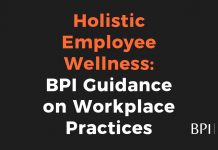People analytics transforms workforce data into actionable insights, enabling organizations to understand workforce dynamics and design targeted interventions. Gallup research links respectful, inclusive cultures to 21% higher profitability and 24% lower turnover. Similarly, McKinsey finds that companies with inclusive practices show 25% higher operating margins.
Quantitative monitoring consistently shows that representation, engagement, and experience matter, and that data-led inclusion contributes to bottom-line performance.
Research and analytics become essential tools that enable segmentation by demographic dimensions and tenure to uncover hidden gaps. This enables decision-makers to allocate resources based on empirical need rather than assumptions.
Best Practice Institute, via Most Loved Workplaces, builds tailored dashboards that track specific employee experiences by department, role, and tenure. This granular tracking reveals both progress and gaps, and drives targeted interventions.
Designing Inclusion Metrics that Deliver Impact
Effective inclusion programs hinge on selecting data points that map to clear outcomes. We identify three foundational metric categories:
- Representation: Measuring representation across levels, roles, and demographic groups reveals pipeline gaps.
- Sentiment: Engagement and belonging surveys—especially peer-based and validated tools—reveal how valued employees feel.
- Behavioral Indicators: Data on participation in career development programs, resource group membership, mentorship, and retention patterns demonstrate real inclusion in action.
Deloitte’s 2023 LGBT+ Inclusion @ Work survey, for example, found organizations sustaining LGBTQ+ inclusion across operational regimes scored higher on belonging, suggesting connecting policy and lived experience matters. The same is true for every young professional, especially younger Gen Z professionals entering the workforce.
Measuring these dimensions quarterly establishes a predictable cadence. It drives leadership attention and establishes accountability through KPI alignment, turning sentiment data into an executive-level KPI. Behavioral metrics, for instance, capture actions, participation in ERGs, ally training completion, incidents reported, and retention rates. These data points allow continuous progress tracking.

Comparing BPI Analytics Tools vs Gallup Surveys
Gallup surveys provide a high-level inclusion snapshot. Their metrics on respect and belonging are valid, but they often can overlook identity-specific experiences such as those of LGBTQ+ staff.
In contrast, BPI uses MLWs platform that integrates both survey and HR data, for richer insights. We layer sentiment with staffing flows, team assignments, and experience metrics.
This enables real-time trend analysis. For example, you might see LGBTQ+ turnover spike in particular locations, data that prompts timely leadership response.
We also support predictive analytics. When we see sentiment dip and manager changes coincide, we can preemptively support teams before issues escalate.
If you’d like to compare Gallup-style survey insights to our integrated analytics dashboard, request a demo here.
Implementing Dashboards for Continuous Monitoring
We help champion leaders who embrace technology to track inclusion instead of relying on assumptions. Our Best Practice Institute platforms integrate HR data with sentiment measures to show real-time insights about LGBTQ+ experience across the organization.
Teams benefit from dashboards reflecting intersectional data, retention, promotions, engagement, ERG participation, and incident reporting. These dashboards support trend spotting and focus. For example, if we see attrition rise among LGBTQ+ staff in a region, we surface it immediately.
Unlike annual surveys, our dynamic tools monitor monthly or quarterly shifts. This allows leaders to test interventions and observe their effect over time. It also helps to calibrate resource allocation based on actual need.
Quality data depends on trust. Research shows that analytics must be paired with transparent communication to avoid suspicion or resistance. We help leaders frame dashboards as tools for equity and empowerment.
Integrating Analytics with Leadership Governance
High-performing organizations connect analytics with governance structures, which are then integrated into ERP systems for analysis. This analysis drives further decision-making on executive levels, giving a broad overview of the company’s performance and its people.
Executive sponsors, HR leaders, and data owners often meet monthly to review inclusion dashboards. These metrics inform resourcing, manager training, and strategic planning.
Gallup emphasizes that accountability completes the analytics cycle. Data without purposeful decision-making limits impact and, in turn, gives employees a voice. ESG metrics, for instance, provide a clear overview of the “will of the workplace.” Analytics must therefore feed into leadership forums and budget reviews.
For example, Southern Veterinary Partners offers industry-leading analytics to hospitals and implements the same in its own workplace. When they noticed region-specific inclusion drops, their team responded with manager coaching and communications campaigns customized based on local metrics. This resulted in measurable upticks in belonging and retention.
Reliable governance aligns data with action across planning cycles. It ensures inclusion becomes part of strategic management alongside financial performance and hiring goals.
Case Study: Southern Veterinary Partners’ Analytics-Backed Cycle
Southern Veterinary Partners (SVP) uses people analytics to inform inclusion at scale after earning MLW certification in 2024. They deploy quarterly pulse surveys capturing belonging, manager effectiveness, and resource group activity.
In the first year post-analytics implementation, SVP reported a double-digit improvement in belonging scores and a meaningful drop in early-career turnover. SVP embeds analytics reviews into leadership meetings, ensuring action follows insight.
Balancing Ethics, Privacy, and Data Utility
Ethical governance is the foundation of trust in analytics. Data collection must follow privacy laws like GDPR, especially when dealing with sensitive group data. Aggregation safeguards and anonymization are essential in small teams.
Transparency further builds confidence, both for the users and the employees whose data is collected. Organizations must communicate purpose, use, access protocols, and allow opt-out mechanisms. This clarity encourages honest participation and accurate reporting.
However, leaders must use data to support, not penalize. Analytics should identify areas for leaders for development rather than assign blame. When a team’s sentiment score falls, the response should be coaching and resource allocation, not punitive oversight.
Including these safeguards in day-to-day and business decisions makes analytics both effective and sustainable, aligning with best practice frameworks such as those described by Deloitte, and PwC.
The Business Case for Inclusion-Centered Analytics
Analytics-driven inclusion goes beyond HR—they deliver financial benefits. McKinsey shows organizations scoring highest on inclusion outperform financial peers by 25–35% Similarly, Gallup links inclusive environments to better profitability and turnover reduction.
Analytics also enables efficient investment. SVP could redirect DEI resources from regions with healthy scores to clinics needing manager development—demonstrating strategic budget use based on real data.
With Gen Z, a demographic leaning heavily on inclusion criteria, making up 27% of the workforce, investment in analytics now supports next-gen talent alignment. Inclusion metrics then become part of strategic planning alongside financial and operational KPIs. Analytics leads to inclusivity with precision, supporting organizations to optimize talent outcomes.
Best Practice Institute guides clients in creating quarterly scorecards that align with leadership KPIs. That builds accountability and embeds inclusive thinking into management routines. If you’re ready to align inclusion metrics with your strategic goals, our consulting team can help.

Ready to see how people analytics can advance your inclusion goals? Contact us today to get started.










